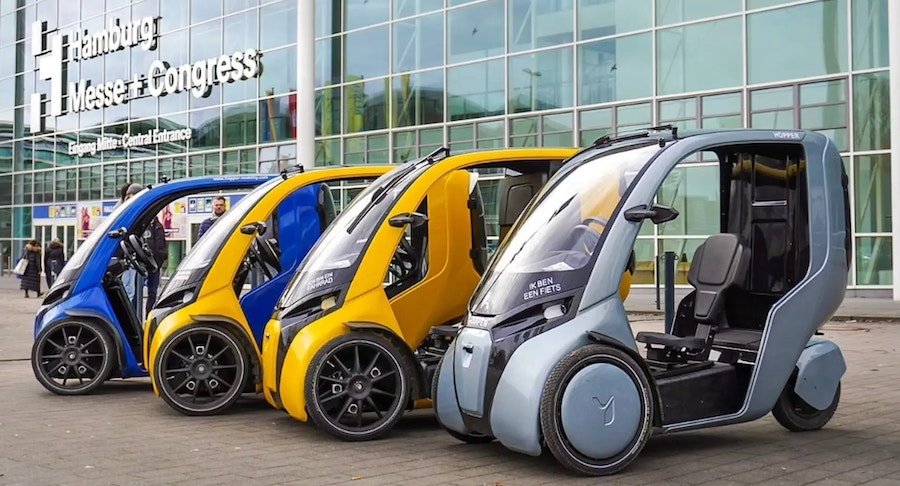Hopper Is a German-Built Three-Wheeler That Unifies the Benefits of E-Bikes and Cars

As the modern world faces various environmental challenges, city dwellers are increasingly looking for more sustainable and energy-efficient mobility solutions for their daily commutes. Many people are willing to ditch their gas-guzzling cars in favor of a more eco-friendly transportation solution, but they still want something that can offer them more comfort and stability than the plain old e-bike.
Hopper could prove a great companion for urbanites looking for a sustainable and efficient commuting solution to navigate through the city without giving up on comfort. This tricycle/car hybrid from German mobility startup Hopper Mobility is designed to offer the best of both worlds - the flexibility, agility, and sustainability of an e-bike combined with the enhanced comfort and stability of a compact car.
The light electric vehicle, which was first presented as a concept in 2020, is a three-wheeler equipped with two comfortable seats, a roof, and a large windscreen and is open at the sides. The seats, steering wheel, and operating concepts are very similar to those of a car, but according to the manufacturer, the Hopper is a bicycle under traffic law, but it can be operated on both bicycle lanes and regular city streets.
However, thanks to its partially enclosed exterior, it provides protection against the weather and higher road safety compared to bicycles. At the same time, it's more eco-friendly and practical than an ICE car.
In terms of dimensions, the Hopper is 212 cm (6 feet 11 inches) long and 115 cm wide (3 feet 9 inches), which makes it compact enough to navigate between lanes easily, thus helping reduce traffic congestion and environmental impact. It boasts a tadpole trike configuration and rides on two 20-inch bicycle tires in the front and a 10-inch scooter tire in the rear. The rider/driver enjoys a comfortable and relaxed seating position, just like in a car, and there is space at the back for either a passenger or cargo.
Muscle power and an electric motor are combined in an eco-friendly propulsion system. The 250-watt rear hub motor enables the e-trike/car hybrid to reach a top speed of 25 kph (16 mph), meaning it fits into the e-bike/pedelec regulations. The motor is fed by a 30-Ah, 48V, 1,440-Wh lithium-iron-phosphate battery, which should provide a range of up to 65 km (40 miles) per charge. The battery is removable and can be charged from any household socket.
The Hopper can be optionally equipped with a rooftop solar panel that will boost that figure. The Hamburg-based company says that, with solar energy, riders will get an additional 5 km (3.1 miles) of range for every hour in sunlight. Moreover, energy is recuperated while riding downhill or braking.
The hybrid vehicle has a rear-wheel steering design and utilizes Mando's powerful chainless drive system Pedalrite, which means it will require much less maintenance, as there are fewer wearing parts compared to a transitional chain drive. So, steering is done by the rear wheel, with a turning radius of 2 meters (6.5 feet), and the Hopper also has a reverse gear. A display integrated into the steering wheel will showcase control data.
Hopper Mobility plans to start series production of the First Edition of the Hopper e-bike/car hybrid, which they say has the potential to revolutionize urban transport, in mid-2024. However, the company has already built 30 units with European Union funding. These test vehicles were given to pilot customers, both private individuals and companies, with the aim of collecting real-world feedback to incorporate into the design of the commercial version of the vehicle.
The German mobility company plans to produce two versions of the Hopper - the Passenger model with a second seat for an adult passenger or two small children and the Cargo model that has a lockable 300-liter cargo compartment behind the driver's seat. While the first will let drivers take friends, grandparents, or the kids on joy rides, the latter is more focused on functionality, allowing them to easily carry shopping bags, sports bags, drink crates, and more. Both versions will support a maximum passenger/payload weight of 160 kg (353 pounds).
Other noteworthy features of the vehicle include a full lighting system (with two 550-lumen headlights), a parking brake and wheel-immobilizing security system, a windshield defogger, and USB ports for charging mobile devices.
All in all, Hopper is not a full-fledged car but represents a promising transportation solution for city dwellers. With its blend of practicality and eco-friendliness it could be a great option for those who want to replace the car in urban environments.
As mentioned, production of the First Edition line should begin in the following months, but German customers can already preorder it for a base price of €13,500 (about US$14,677). At least 60 units of the Hopper will be produced in the first run, with delivery planned for the second half of 2024. Availability will reportedly be extended to other countries as well.

Related News


